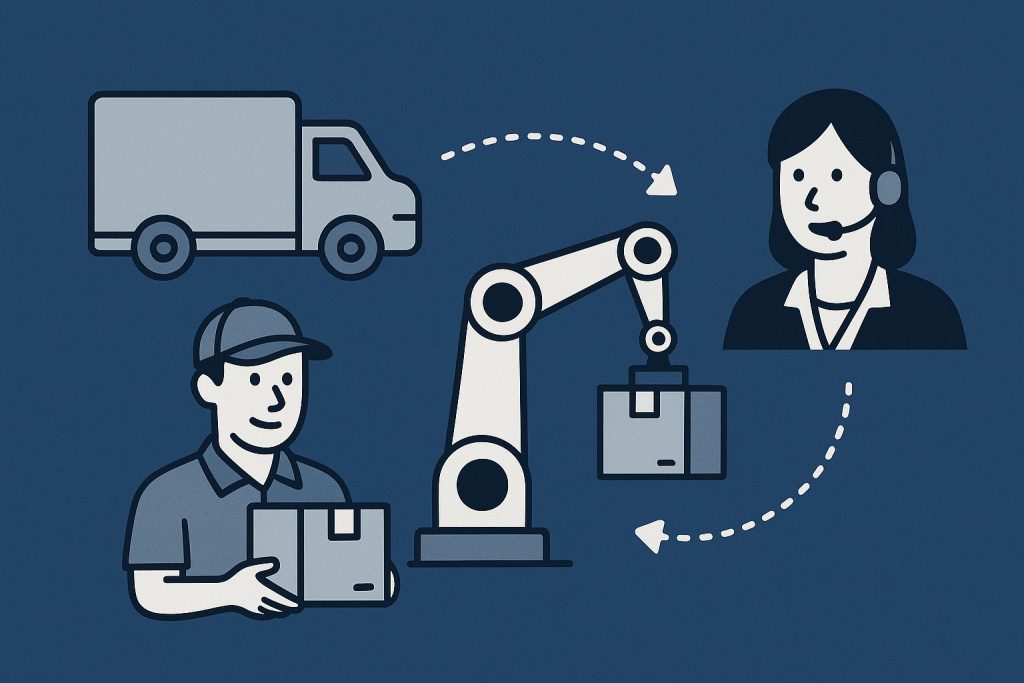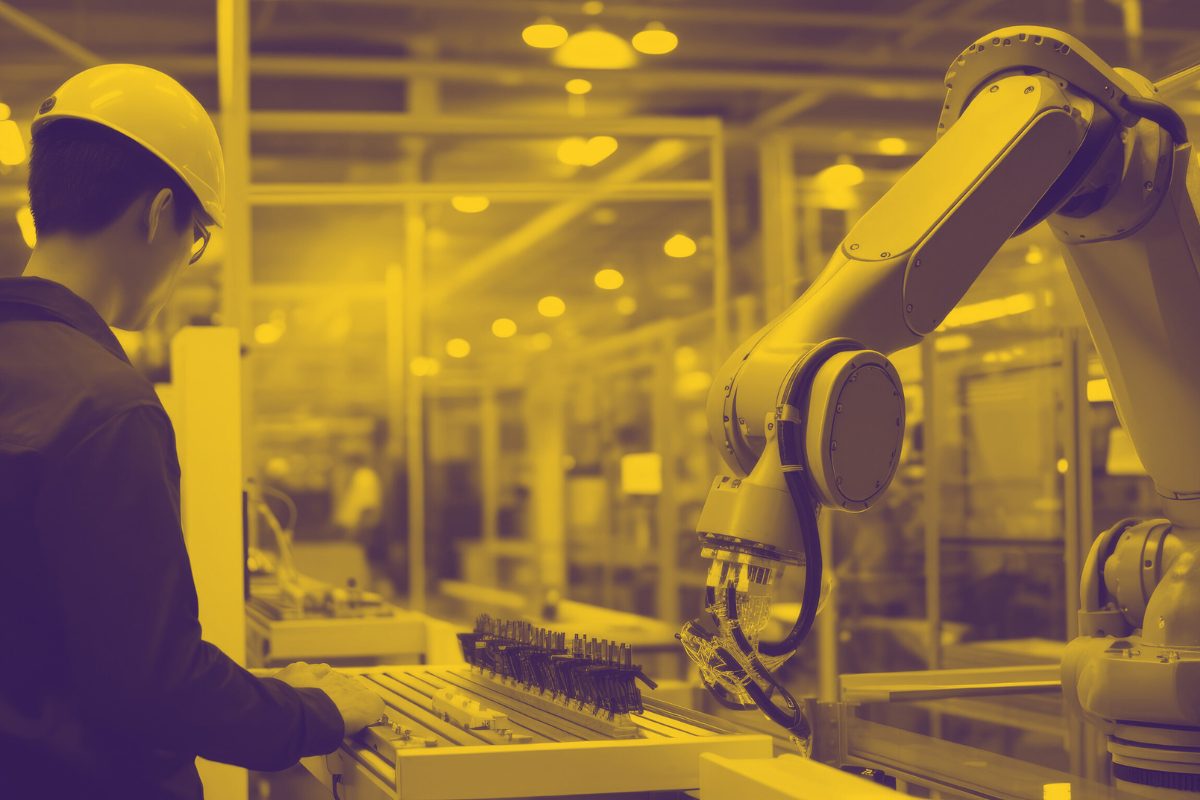
What is an autonomous supply chain?
An autonomous supply chain uses data infrastructure, AI/ML and connected automation to monitor conditions in real time, recommend or execute actions, and continuously improve with limited manual intervention. Think of it as moving from deterministic, rule-based automation to adaptive, learning-driven autonomy. Pillars typically include real-time visibility (often via digital twins), predictive planning, automated execution, and exception self-healing—with humans providing oversight and judgement on the edge cases that matter most.
Momentum is building across industries, but most supply chains are still early in their journey, underscoring the need for pragmatic, staged adoption.
The technologies making autonomy real
1) Data infrastructure and digital twins
IoT sensors, telemetry, and well-governed data pipelines feed digital twin models of plants, warehouses and networks. These twins simulate scenarios, detect anomalies and propose optimisations—key to self-monitoring and self-healing.
2) Advanced analytics and AI
Machine learning models forecast demand, detect outliers and prescribe actions. As organisations mature, they blend predictive and prescriptive analytics with reinforcement learning to manage trade-offs such as service level, cost and carbon.
3) Automated execution
From automated storage and retrieval systems to AGVs and robotic picking, execution automation turns plans into physical flow. In logistics, algorithmic routing and dynamic slotting compress lead times while improving asset utilisation. Orchestrated by control-tower visibility, these are common stepping stones towards autonomy.
4) Exception handling with a human in the loop
No matter how smart the stack, real life throws curveballs—supplier defaults, weather events, data quality issues, regulatory checks. Best-practice models explicitly design for human-in-the-loop oversight and escalation paths. This is where high-skill remote teams, such as outsourced Filipino specialists, keep the system safe, fast and adaptable.
From automation to human + machine collaboration
The shift isn’t about replacing teams; it’s about changing where humans add value. Autonomy excels at routine pattern recognition and repeatable actions. People excel at ambiguity, context, negotiation and scenario design. Mature organisations partition work so machines handle steady-state flow while people manage exceptions, interventions and improvement.
In practice, this means re-tooling roles around decision support, oversight and continuous improvement—exactly the kind of work that can be delivered efficiently via offshore staffing in the Philippines. The result is a resilient operating system that scales without spiralling costs or risks.
Why the Philippines remains a smart hub for outsourcing
The Philippines’ IT-BPM sector has grown strongly and continues to expand. That expansion isn’t despite AI—it’s increasingly with AI, as providers move up the value chain into analytics, engineering and operations roles.
At a strategic level, the country is shifting towards higher-value outsourcing—software, data analysis, architecture, legal process—and embedding Filipino professionals inside multinational workflows. This evolution suits the hybrid human-machine model required by autonomous supply chains.
Enduring advantages for US, UK and Australian clients
- English-first delivery, cultural alignment and strong service ethos.
- Scalability and cost efficiency for 24/7 coverage and seasonal flex.
- Time-zone overlap windows with North America, Europe and APAC—ideal for follow-the-sun operations.
- Industry maturity in finance operations, procurement, logistics coordination, data operations and customer experience—now augmented by AI.
Where outsourced Filipino teams add the most value in autonomy
Below are practical roles teams can take on immediately to help your organisation adopt AI while keeping humans in control.
| Function | Autonomous context | Value delivered |
|---|---|---|
| Data pipeline stewardship | Monitoring ETL jobs, API feeds, IoT streams feeding your digital twin | Rapid anomaly detection, first-line fixes, vendor coordination; improved data quality for forecasting |
| Exception resolution | Issues flagged by planning engines or control towers (stock deltas, carrier delays) | Human adjudication, root-cause notes, escalation; faster recovery loops |
| Scenario simulation support | What-if planning, sensitivity analysis, stress tests | Batching simulations, interpreting results, drafting playbooks for planners |
| Supplier and carrier liaison | Wrap-around for automated procurement and routing | Negotiations, exceptions, rebooking, service recovery with human rapport |
| Quality and audit | Sampling AI decisions for bias, accuracy and compliance | Assurance reporting, feedback to retraining datasets |
| KPI and control-tower operations | 24/7 dashboard oversight across regions | Proactive alerts, playbook execution, lessons-learned capture |
| Content and data labelling | Improving model performance and domain alignment | Faster model iteration, reduced drift, better explainability |
If you’re earlier in your journey, outsourcing these roles provides capability and coverage without the overhead of full in-house teams—letting you test and learn before scaling.
Use cases: human-guided autonomy in action
E-commerce fulfilment with robotic picking
A fashion retailer deploys robotic picking and predictive replenishment. When a count discrepancy or order-priority conflict triggers an alert, a Philippine-based operations specialist reviews the context, confirms the signal and issues a targeted override—documented in the control tower. Resolution time drops, and the incident becomes training data for the next model iteration.
Global procurement with automated sourcing
A manufacturer’s sourcing engine proposes alternatives during a supplier hold. A Philippine-based procurement coordinator validates quality data, negotiates a rapid short-term contract, and feeds post-mortem notes to the system so future recommendations weight supplier reliability more intelligently.
Logistics control tower with dynamic routing
A 3PL network uses predictive ETA models and dynamic routing. When customs delays cascade, offshore staffing covers after-hours exception handling, reroutes time-sensitive shipments, and communicates with carriers, avoiding SLA penalties across US, UK and AU lanes.
What the data says about the market outlook
Independent and industry sources point to steady progress towards autonomy and a clear role for people. Companies are building the foundations—data, twins, analytics—even as many processes remain manual.
On the talent side, the Philippines’ IT-BPM sector continues to grow, with a deepening pool of talent ready to slot into AI-assisted operations.
Risks, constraints and how to manage them
Autonomy introduces new dependencies such as data quality and model behaviour, while cross-border staffing introduces operational considerations including access control and process clarity. None of these are show-stoppers—provided you design for them up front.
- Latency and handoffs: set overlap windows, structured playbooks, and a tiered escalation ladder.
- Security and compliance: enforce role-based access, SSO/VPN, encryption, and audit trails for every override.
- Model trust: start with supervised autonomy; require human validation for high-impact actions; capture decision rationales.
- Skills and training: hire for domain plus data literacy; run enablement sprints on tools and metrics.
- Integration friction: standardise APIs, harmonise master data, and phase deployments through pilot zones.
A staged transformation works best: begin with a pilot, validate outcomes, then scale to adjacent processes.
How to build your hybrid autonomous + outsourced model
- Map readiness: audit data pipelines, planning cadence, exception volumes, and current automation gaps.
- Choose a pilot zone: a warehouse, routing lane, or sourcing category where you can measure lift.
- Define the human touchpoints: clarify when humans review, approve, or override; codify the RACI and SLAs.
- Stand up a small, cross-functional team in the Philippines: blend operations analysts, coordinators and data stewards; start with coverage that supports your in-house team’s daytime.
- Instrument everything: dashboards for KPIs, exception age, first-contact resolution, and incident taxonomy.
- Iterate monthly: review exceptions, update playbooks, feed labelled data back into the models, and reduce manual touches where safe.
- Scale horizontally: add adjacent flows—returns, capacity planning, supplier risk—while deepening automation and guardrails.
If you’re designing around a control-tower concept, this staged approach serves as the springboard to autonomous planning.
Where USource fits (and helpful resources)
USource blends AI outsourcing literacy with hands-on operational know-how. Whether you’re piloting a digital-twin initiative or simply need reliable after-hours exception handling, we assemble teams that plug into your stack and scale as you go.
- Virtual Assistants – for cross-functional operational support and exception handling.
- Data and Analytics – for data quality, dashboarding, and model support.
- Customer Support – for end-to-end CX in e-commerce and logistics.
Conclusion: the future is hybrid
Autonomous supply chains aren’t a sci-fi destination; they’re a practical evolution already under way. The most effective operators will let machines handle the routine while skilled people—often in offshore teams—manage exceptions, context and improvement. For leaders in the US, UK and Australia, outsourcing in the Philippines remains one of the smartest ways to get there: flexible capacity, deeper coverage and the right skill mix for AI-assisted operations.
Curious what a pilot could look like in your environment? Explore the resources above, or start with a light-touch discovery to map your first human-in-the-loop autonomy zone. No hard sell—just a clear plan to lower risk and raise performance.

FAQs: People Also Ask
What’s the difference between automation and autonomy in supply chains?
Automation follows predefined rules to perform tasks; autonomy senses, decides and acts with adaptability, learning from outcomes and managing exceptions with human oversight when needed. Digital twins, AI forecasting and control-tower orchestration are typical components of autonomous setups.
Do autonomous supply chains eliminate the need for offshore staffing?
No. Autonomy reduces repetitive manual work but increases the need for judgement around exceptions, governance, and improvement cycles. That’s why many organisations pair AI with offshore staffing—for 24/7 oversight, supplier coordination and scenario support.
Why outsource to the Philippines for AI-assisted operations?
The Philippines combines deep service experience with strong English proficiency and growing capability in higher-value roles. The sector continues to expand—especially where humans collaborate with AI.
What roles should I outsource first?
Start with exception handling (after-hours coverage), data pipeline stewardship, control-tower monitoring and supplier or carrier liaison. They offer quick wins, clear KPIs and low integration risk—ideal for validating your hybrid model.
Which KPIs matter most in a pilot?
Exception age and closure rate, forecast error (such as MAPE), service level (OTIF), cost-to-serve, and the percentage of autonomous versus human-assisted decisions. Track these before and after to quantify impact and guide where to automate next.

